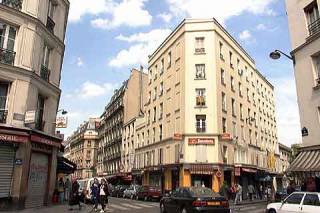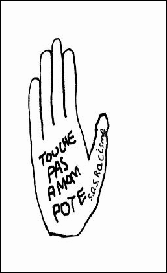Since the earliest times the Mediterranean area has been crossed by pilgrims traveling to sanctuaries, sacred places, and looking for new opportunities and new markets for trade. Nowadays, as in earlier times, this pilgrimage goes on, but it involves prevalently the people living in the South of the Mediterranean who are bound for the new sanctuaries of globalization: large European cities. These pilgrims, like their predecessors, bear hopes for a better future that is often impossible or difficult to realize in their homeland, because of economic problems and sometimes fratricide wars. Music accompanied the journey of ancient pilgrims towards the sanctuaries.
They were forced to take part in French history, French economy, and also in France’s wars. Some Maghrebi quarters were developed in Paris. The most famous was and still is Barbés (18éme arrondissmenent)
This immigration - sometimes during wartime it was referred to as deportation - involved predominantly men who worked in factories. Many Algerians remained in Paris in spite of the retaliations of the French against Algerian immigrants and the massacres of Algerian protesters during the Algerian Liberation War (Liauzu 1996: 126) - such as in October 1961 when many protesters were murdered and thrown into the Seine. In 1975 the French government changed the immigration law and authorized the families of Algerian immigrants to join them in France. Therefore "Les Maghrébins représentent en 1982 38,5% de la population étrangère, mais c’est moins désormais l’entrée de travailleurs que le regroupement familial qui joue, l’immigration de main-d’œuvre a tendu à devenir une immigration de peuplement" (Liauzu 1996: 122). The families brought their children, and more children were born in France, producing a second generation. French people call this young generation 'jeunes issus de l’immigration' or beurs. Beurs have a different identity both from Algerian immigrants and from French people of their age group. Algerian immigrants experience two different aspects of displacement: being up-rooted from their homeland and adapting to a foreign culture; on the other hand, their children - who were born and study in France - experience a displacement of identity. Beurs are suspended between the parents' background and the everyday life of French society. Therefore, I have chosen the word 'suspended' since often they are not accepted either into Algerian or French society. In France beurs are seen as immigrants, even if they have often a French education and nationality (Khellil 1991: 88-105). On the contrary, in Algeria they are seen as French or, if worse come to worse, as 'traitors' to Algerian culture. The beurs’ experiences (in particular for girls) of going back to Algeria - for instance, during the holidays with their parents - are sometimes really traumatic. For example, beur boys are often called by offensive names, such as 'l’émigré', but the beur girls are referred to as amjah (lost) and merula (a woman of loose morals). During my fieldwork some beurs told me about these problems stating "in Algeria I’m seen as an immigrant, a foreigner." We may suppose that a lot of the resentment experienced by visiting beurs is probably fuelled by jealousy, as very many Algerians cannot leave the country and face long-term unemployment at home.
These demonstrations and marches emphasized for the first time the problems of beurs more than the beur-problem. There were important discussions in French society (which even now are still relevant) about its relationship with the beurs and their status in France (Khellil 1991; la Coste-Durjardin 1992; Bachmann 1992). French politicians and the government followed these discussions with interest. Different theories were proposed, the most important among them being the 'assimilation policy' and 'integration policy' (Khellil 1991: 37-60; Manço 1999: 31-95). It may be useful to take a brief look at both. The principal characteristic of assimilation is the up-rooting of cultural differences resulting in the disappearance of many aspects belonging to the culture of origin. The dominant culture is recognized as all-important. Assimilation is a colonialist concept and until 1960 was the model for immigration laws in France. Due to harsh criticism the assimilation concept was replaced with integration. Integration is founded upon five fundamental concepts: equality of rights; the fight against discrimination; compensation for inequalities; participation in political and social life; the right to French citizenship. In spite of all that, Jacqueline Costa-Lascoux (1999) highlights that integration can be interpreted as a 'softer' type of assimilation. It may seem that these questions are of interest only to sociologists or politicians, but also beurs and immigrants have their points of view (cf. Charlot 1981). In this article I'll try to show that beurs criticize both those who consider them as immigrants as well as the supporters of assimilation and integration policies. In most cases the beurs express their refusal of assimilation or integration through two different types of behavior: on the one hand, they come into conflict with society (including criminal acts); on the other hand, they use art, music, and theater as socially acceptable tools of confrontation. Since beurs see themselves as French citizens, every special policy aimed at their assimilation/integration is perceived as a racist attitude against them, an exclusion from French society with the aim of constructing a sort of ' Indian reservation ' for them within French society. But it should be added that beurs have a profoundly different vision of French culture in comparison with most French people. During my fieldwork someone told me: "I don’t have to eat pork and drink alcohol in order to be a French citizen. Praying five times per day and speaking Arabic doesn't prevent me from being French citizen." Despite their sense of belonging to French society, the youth define themselves as French-beurs, where the word beur wants to be a symbol of a specific cultural identity: the beur-culture (Fahdel 1990: 140-152; Khellil 1991: 71-85; Reynaert 1993: 18). In order to understand the complex reality of the Algerian immigration in France (2), it is important to take into consideration another point. We have seen above that there are some relational problems on the one hand between beurs and French society and on the other hand between beurs and Algerian society, but there are also some differences between beurs and immigrants. In particular, different attitudes to the so-called 'myth of return' (Khellil 1991: 21-38; La Coste-Dujardin 1992: 7-103) should be mentioned . The immigrants dream of returning permanently to their native country, but the day of this return is postponed time after time. An immigrant expresses this will both before the departure from his homeland and during his whole life abroad but often he never goes back. The topic of return is common in conversations with friends and relatives. Sometimes even a date is fixed but generally it is not respected. Indeed, home-coming often remains only a myth. The 'myth of return' is an immigrant’s distinctive peculiarity. On the contrary, with the word 'return' the beurs refer to France and not Algeria as their destination. This is absolutely clear in the words of most beur-girls, who live in dread of 'returning' to Algeria because they are worried about the possibility of being married to an Algerian man. For them, the 'myth of a return' is transformed into a 'nightmare of return' (La Coste-Dujardin 1992: 100). |


